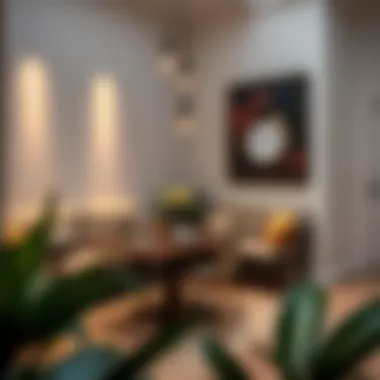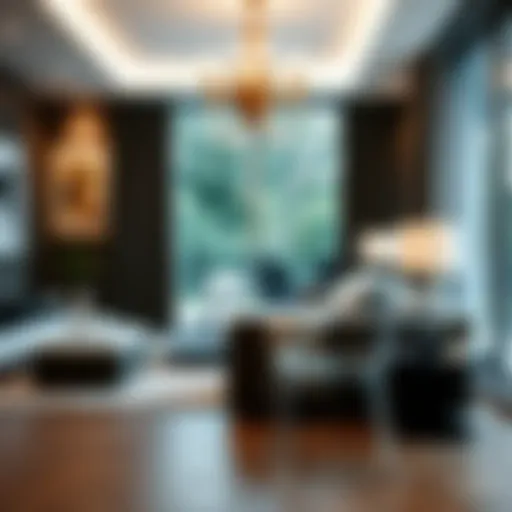Comprehensive Guide to Corner Dining Seating


Intro
Corner dining seating has emerged as a compelling option for home and restaurant spaces alike. With its unique ability to optimize not just space but also enhance the overall dining experience, it has garnered attention from designers and homeowners seeking innovative solutions. This guide aims to unpack the multifaceted aspects of corner dining arrangements, addressing their practical benefits, the aesthetics they offer, and the diverse styles available. It will detail how to incorporate these seating options into various dining environments while considering the specific layout and ambiance of your space. Let's begin a closer look at the design trends that are shaping the realm of corner dining seating.
Design Trends
Current Trends in Furniture Styles
Furniture design is hardly stagnant, and corner dining seating is not exempt from the ever-shifting tides of trends. Many interior designers are now focused on combining functionality with aesthetic appeal. Currently, materials such as reclaimed wood and mixed metals are gaining traction. This blend not only creates a rustic yet modern look but also promotes sustainability, appealing to environmentally-conscious consumers.
Moreover, minimalism continues to reign supreme. Clean lines and less ornamentation create an airy feel, especially important for smaller dining spaces. Think of a sleek corner bench paired with a simple, round table—functional yet stylish.
Popular Styles Include:
- Scandinavian: Emphasizes light woods, soft colors, and functionality.
- Industrial: Features raw materials like metal and exposed brick, suitable for loft-style interiors.
- Transitional: A mix of traditional and contemporary designs offering versatility.
How to Incorporate Trends into Your Space
Adopting these trends doesn’t mean a complete overhaul of your dining area. Start by selecting a corner bench that aligns with your desired aesthetic. If your home has a cozy, inviting vibe, a plush, upholstered seat might be ideal. For a modern look, opt for a wooden bench with sleek lines.
When integrating new pieces, keep in mind the color scheme and existing decor. For instance, if you have predominantly neutral tones, a bold-colored cushion on the bench can act as a statement piece without overwhelming the space. Additionally, consider the layout of your dining area. Corner seating can be a great way to utilize an often-overlooked nook, allowing for easy traffic flow and maximizing seating potential.
Buying Guides
Choosing the Right Furniture for Different Rooms
Selecting the right corner dining seating requires thoughtful consideration of the specific room in question. If the area is primarily for casual meals, a comfortable bench with soft upholstery can create a relaxed atmosphere. However, if it’s more for entertaining guests, a sturdier, more formal setting might be appropriate.
Key Factors to Consider:
- Dimensions: Ensure that the seating fits well without crowding the space.
- Comfort Level: Test different options; comfort is paramount.
- Material Durability: Choose materials that can withstand everyday wear and tear, especially if kids or pets are involved.
Tips for Assessing Quality and Value
Quality can make or break your investment in corner dining seating. Look for craftsmanship that speaks to longevity, such as strong frames and high-quality upholstery. One practical tip is to check reviews and ratings online. Websites like Reddit can provide real-user feedback about various brands
When comparing prices, remember that higher costs do not always equate to better quality. Instead, focus on what is essential for your space and look for options that offer the best blend of functionality, aesthetic appeal, and durability.
"The key to a successful dining arrangement is balance: a touch of comfort, a splash of elegance, all wrapped in functional design."
Understanding Corner Dining Seating
Corner dining seating has become a pivotal element in the landscape of modern meal-time experiences. It isn't just about squeezing in a few extra chairs; it's about crafting a cozy nook that combines functionality with aesthetic appeal. The configuration allows for a seamless blend of informal gatherings and intimate dinners, catering well to families and guests alike. Exploring this topic opens up a treasure trove of design possibilities, which can range from sleek, contemporary styles to warm, rustic settings.
Definition and Purpose
So, what exactly is corner dining seating? In essence, it refers to seating arrangements designed to fit snugly into corners of dining areas. These can include benches, corner sofas, or booth-style setups. The purpose goes beyond just saving space; it enhances the dining experience by fostering conversation and creating an inviting atmosphere.
- Space Efficiency: One of the standout benefits of corner seating is its ability to optimize underutilized areas, transforming them into functional dining spots without cluttering the surroundings.
- Social Hub: Ensuring that everyone is closer together encourages interaction. It provides a sense of togetherness that is often missing in traditional dining setups.
- Visual Appeal: When done right, corner seating can serve as a beautiful focal point in the room, showcasing unique materials or designs that reflect personal style.
Whether you’re designing a small apartment or a spacious dining hall, integrating corner seating can add both character and practicality, enhancing overall utility.
The Evolution of Dining Spaces
The shift in how we utilize dining spaces has been nothing short of remarkable. Formerly, formal dining rooms dominated the scene, often featuring large tables surrounded by matching chairs. However, with the advent of more casual lifestyles and the blending of living spaces, the evolution of dining areas has taken a different turn.
- Functionality First: Today, dining spaces are not solely about eating; they are multifunctional, serving purposes from workspaces to gathering spots for friends.
- Flexible Arrangements: The rise of remote work has changed our perspectives on home design, steering us towards adaptable spaces. Corner dining seating fits right into this narrative, allowing users to reconfigure their setups as needed.
- Blurring Boundaries: Modern design has moved towards an open-plan layout, where dining areas flow seamlessly into living spaces. Here, corner seats can serve as natural separators while still maintaining an open feel.
This evolution in dining spaces reflects broader shifts in society—where practicality, flexibility, and social interaction take precedence over formality. Corner dining seating stands out as a prime example of how innovative design can meet these changing needs, ensuring a welcoming environment tailored to contemporary lifestyles.
Design Considerations
Design considerations in corner dining seating are vital because they dictate both functionality and aesthetic appeal. When homeowners or designers approach the creation of a dining space, understanding the interplay of elements like space utilization and style compatibility can transform a mere seating arrangement into a harmonious blend of form and function. By carefully selecting how one utilizes these elements, the dining area can become a more inviting and versatile space.
Space Utilization
Maximizing the available area is a crucial element in designing corner dining seating. Often, corners in rooms are overlooked, yielding wasted potential that could otherwise enhance the dining experience.
Maximizing Small Spaces


When dealing with small spaces, the incorporation of corner seating offers a unique advantage. It allows for better traffic flow while giving ample seating without taking up too much real estate. The key characteristic of maximizing small spaces lies in its clever use of angles and nooks to create a snug dining area that feels large enough yet intimate.
- The benefit is clear: by placing a unit in the corner, you can house a table without encroaching on the room itself, opening the floor plan significantly. A corner bench, for instance, occupies less space and can often serve dual purposes, such as storage.
- Unique features involve functional design elements, such as foldable tables or expandable benches, which provide adaptability, especially beneficial in multipurpose areas. However, one ought to consider that small spaces can feel cramped if not executed with care, making practicality crucial.
Creating Intimate Atmospheres
In the realm of dining, the ambiance can make or break the experience. Creating intimate atmospheres through corner dining seating relies heavily on comfortable arrangements that encourage interaction. The beauty of a corner setup is its ability to cocoon diners, making conversations more personal and engaging.
- The essential characteristic is the ability to create a snug fit that promotes easy conversation. Unlike traditional seating arrangements that can make diners feel isolated, a corner setup fosters closeness.
- Unique features might include soft upholstery paired with warm lighting that can make the space inviting. However, one must ensure that the selection of colors and textures aligns with the overall theme to avoid clashes that can detract from the intended coziness.
Style Compatibility
The design of corner dining seating must also align with the desired style of a home. This leads us to the next consideration: style compatibility. Without this alignment, the seating may seem like a square peg in a round hole, failing to achieve cohesiveness with the rest of the decor.
Modern Aesthetics
The rise of minimalist decor has ushered in a demand for modern aesthetics in dining areas. Such designs prioritize sleek lines and functionality without compromising on style. A defining trait of modern aesthetics is the embrace of open spaces and uncluttered arrangements.
- The advantage of modern designs is their ability to make spaces feel airy and light, which can be particularly beneficial in urban dwellings. Materials like metal and glass often feature in this style, providing durability paired with a chic look.
- The unique feature here is the blending of styles; for example, a stark white corner sofa might be complemented by a rustic wooden table, bridging gaps between traditions while maintaining modernity. Yet, an over-reliance on modern aesthetics may lead to a sterile feel unless balanced correctly.
Rustic Charm
On the flip side, rustic charm embraces a more inviting and down-to-earth approach. This style evokes warmth and nostalgia, capitalizing on natural materials and textures. Key characteristics include floating shelves made from reclaimed wood or plush, oversized cushions that promise comfort and style.
- Choosing rustic options often leads to a homey feel, where the use of earthy tones provides a soothing backdrop for dining. One advantage of rustic charm is that it often tells a story, becoming a conversational piece in itself.
- Unique features could be ornate details and handcrafted elements that embody artisanal skill. While entertaining, be cautious of overloading on decor, as it can detract from the effortless charm that rustic spaces strive to accomplish.
Types of Corner Dining Seating
Understanding the various types of corner dining seating is crucial for anyone looking to optimize their dining area. Each option brings its own flair and functionality. The right choice can enhance both the aesthetic appeal and the practicality of the space. Here, we will dig into three popular types: bench seating, corner sofas, and booths.
Bench Seating
Bench seating offers a clean, simple design that can be incredibly versatile. Often characterized by its long, unbroken seat, this type of seating is great for maximizing seating capacity without compromising on comfort. Benches can be placed against walls or fitted into corners, making them ideal for small dining spaces.
Benefits of Bench Seating:
- Space Efficiency: Their linear design allows for more people to be seated compared to individual chairs.
- Flexible Arrangement: Easily moved or reconfigured for different occasions, from intimate family dinners to larger gatherings.
- Creative Customization: You can upholster benches in varying fabrics and colors to match your existing decor or make a bold statement.
In using benches, consider the addition of cushions for comfort, particularly if the bench is made from a harder material such as wood. This not only improves comfort but adds an element of design, allowing for coordination with other colors in the room.
Corner Sofas
Corner sofas are another great option, particularly for more casual dining areas. Their L-shape design fits snugly into corners, providing ample seating while creating a cozy, inviting atmosphere. Unlike the traditional sofa set, corner sofas can be both functional and stylish, often becoming a focal point in your dining space.
Key Features of Corner Sofas:
- Comfortable Seating: The depth of a corner sofa allows for a relaxed dining experience, suitable for family meals or leisurely gatherings.
- Variety of Styles: From contemporary to classic, corner sofas come in a range of designs, colors, and materials to fit any aesthetic.
- Social Engagement: The configuration encourages conversation and interaction, making it perfect for dining experiences where guests linger.
If you’re considering corner sofas, think about how easy it will be to clean around them, as this type of seating can sometimes limit access to corners and walls.
Booths
Booths bring a unique charm to any dining area. They often include high-backed seating and can encapsulate diners more effectively than standard seating. Commonly found in cafes and diners, they can also be used in homes for a touch of retro or diner-style dining.
Advantages of Booth Seating:
- Privacy: The high backs provide a sense of enclosure, making conversations feel intimate.
- Child-Friendly: Easier to manage kids, as booths often prevent them from easily slipping off the seat.
- Maximized Space: Booths can often be built into smaller areas more effectively than a table and chairs would allow.
When choosing a booth for your dining space, take note of both the space requirements and the comfort levels, as not all booths are created equal. A booth with a well-padded seat and backrest can keep guests comfortable during long meals.
In summary, selecting the right type of corner dining seating comes down to understanding the specific needs of your space as well as your personal style preferences. Whether you aim for the simplicity of bench seating, the casual comfort of corner sofas, or the cozy appeal of booths, each option serves to enhance your dining experience.
Material Choices
Selecting the right materials for corner dining seating substantially influences not only the aesthetics but also the functionality and longevity of the furniture. Understanding the properties and characteristics of various materials helps homeowners and designers make informed decisions. It’s not just about picking something that looks pretty; it’s about finding a balance between durability, style, and practicality.
Wood Options
Solid Wood Benefits


When you consider solid wood, what often springs to mind is its robustness. Solid wood is a classic choice, known for its ability to withstand wear and tear better than most alternatives. This material boasts a significant advantage with its durability and natural beauty, making it an appealing option for those looking at corner seating. The grain patterns and colors are unique to each piece, adding a touch of personality to your dining space.
One key characteristic of solid wood is its longevity. Unlike some synthetic materials, it can last for decades if properly cared for. This is particularly beneficial in family settings where furniture often faces heavy use. However, solid wood can be prone to scratches and dents, which might require occasional refinishing, but the effort often pays off in the long run when you consider its timeless appeal.
Particle Board Limitations
On the other hand, particle board, though often hailed as a budget-friendly alternative, comes with its own set of drawbacks. While it may be easier on the wallet, this material tends to wear faster compared to solid wood. Its construction involves tiny wood particles glued together, making it less robust. The key limitation here is quite simple: while it’s a popular choice for temporary setups, it might not stand the test of time in a busy dining atmosphere.
One unique feature of particle board is its flexibility in design, allowing for a variety of shapes and finishes, but it lacks the character and resilience of solid wood. In spaces where durability and endurance are paramount, relying on particle board may lead to issues like chipping or delamination, especially in environments with high humidity.
Upholstery Fabrics
Choosing Durable Materials
In the realm of upholstery fabrics, choosing materials that can withstand everyday use is of utmost importance. Fabrics like microfiber or canvas have garnered popularity due to their resistance to stains and ease of maintenance. Their durability makes them suitable for families or anyone who entertains often.
A notable aspect here is that durable materials often come with protective treatments or coatings that resist spills. While you might pay a bit more upfront, the long-term benefits of less frequent replacements and easier cleaning are hard to overlook.
Considerations for Cleaning
When it comes to choosing upholstery, consider how easy it is to clean. Some fabrics, while attractive, are less practical owing to their absorbent nature. For example, fabrics like velvet can be sumptuous but notoriously difficult to maintain. It’s essential to evaluate your lifestyle. If you have kids or pets, choosing fabrics that are both stain-resistant and easy to wipe down can save a lot of headaches down the line.
In summary, while aesthetics matter in corner dining seating, the choice of materials plays a crucial role in defining functionality and longevity. Opting for solid wood and durable upholstery should be at the forefront, ensuring your dining area remains both inviting and resilient for years to come.
Remember that investing in quality materials now can save you a bundle in the long run. Your dining space isn't just an area; it's where memories are created.
Practical Applications in Dining Areas
Corner dining seating offers unique advantages that fit seamlessly into various dining areas, making it both a practical choice and a design element. These spaces are often the heart of the home, where families gather for meals, and friends come to celebrate. Implementing corner seating can transform even modest dining areas into welcoming and efficient spaces.
Family Dining
Family meals are a cornerstone of everyday life. Having a designated corner dining seating area provides warmth and comfort. Here are some key elements to consider:
- Maximized Space: Corner seating utilizes often-overlooked spaces, allowing more room for movement and making it easier to fit more people. This is particularly beneficial for larger families or when hosting special occasions where you want everyone to feel included.
- Harmonious Environment: Arranging seating in a corner creates a sense of intimacy, making family meals feel more connected. Children and adults alike can gather around, fostering conversation and closer interactions.
- Versatility: Flexible designs can allow for additions like cushions or throw pillows, accommodating all ages and preferences. For instance, a removable cushion can add comfort for the kids, while adults may prefer a firmer seat.
Taking all this into account, a corner bench or L-shaped sofa can elevate family dining experiences. In addition, storage solutions can often be tucked under these seats, blending practicality with aesthetics.
Entertaining Guests
When hosting friends or family, the right dining setup becomes essential. Here’s how corner dining seating serves this purpose:
- Enhanced Atmosphere: A corner arrangement allows for a more inclusive atmosphere. It encourages group conversations without straining necks or craning heads, making everyone feel part of the action.
- Design Focus: This seating can act as a statement piece. Choosing bold fabrics or vibrant colors can draw attention and spark interest in the overall decor. Think of creating a focal point around your dining area—using a contrasting upholstery against neutral walls can be eye-catching.
- Functional Flow: Having a corner seat means less disruption to traffic flow. Guests can mingle easily without navigating around traditional chairs, creating a more fluid space for movement between the kitchen and dining areas.
In addition to sliding in a few extra chairs when needed, corner dining setups can be paired with cocktail tables or serving carts, offering a versatile and dynamic entertaining environment.
"Corner seating can be the missing puzzle piece that completes your dining vision, turning a simple space into one of style and conversations."
By recognizing these qualities, homeowners, designers, and DIYers can make informed decisions on how to incorporate corner dining seating into their space, ensuring that family gatherings and entertaining guests both provide memorable experiences.
Color and Finishing Options
Understanding the right color and finishing options is crucial when selecting corner dining seating. Colors can significantly influence the mood and ambiance of your dining space, while the finishing choices can impact both aesthetics and durability. Together, these elements can transform an ordinary corner into a captivating dining area.
The importance of color and finishing lies not just in appearance but also in functionality. The right combination can enhance spatial perception, make the room feel larger or cozier, and even dictate the overall theme of the decor. Thus, it becomes essential for homeowners, designers, and enthusiasts to consider these factors carefully when designing a dining area.
Neutral Palettes
Neutral palettes often serve as the backbone of a design scheme. Shades like beige, gray, taupe, and white provide a versatile backdrop that blends well with nearly any decor style. Choosing neutral colors for your corner seating can evoke a sense of calmness and serenity, making the dining experience more enjoyable.
- Versatility in Design: One of the key benefits of neutral palettes is their ability to adapt. Whether your style is minimalist, contemporary, or anything in between, neutral colors can mesh effortlessly with various decorations.
- Highlighting Accents: This color choice allows for vibrant decor elements to stand out. Think of bright tableware or unique wall art that draws the eye. As such, neutral shades can act as a blank canvas, showcasing other elements in the room without overwhelming them.
- Maintenance Ease: Neutral tones can also be more forgiving when it comes to wear and tear. Spills and stains are less noticeable compared to darker or bolder colors, which can be particularly advantageous for families with kids or pets.
Bold Accents
On the flip side, bold accents inject life and vibrancy into corner dining spaces. Colors like deep blues, rich greens, or fiery reds command attention and define personality. Choosing a bold hue for corner seating can create a stunning focal point in a larger dining area.
- Creating Contrast: Bold colors can help in delineating different areas within a room, especially in open-concept spaces. For instance, a striking red corner sofa could beautifully contrast with a lighter dining table, effectively drawing eyes toward the dining area.
- Mood Enhancement: Color psychology plays a significant role here; brighter shades can elevate energy levels and stimulate conversation. If your dining area is often the center for gatherings, colors like yellow or orange can help create a warm and inviting atmosphere.
- Personal Expression: Ultimately, choosing bold accents allows for personal expression in design. This approach can reflect the homeowner’s personality or even the overall theme of the home, whether modern chic or eclectic.
Maintenance and Care


Maintaining corner dining seating goes beyond mere aesthetics; it vastly influences the longevity and functionality of the furniture. Regular maintenance helps prevent wear and tear, ensuring that these seating arrangements not only look good but also withstand the rigors of daily use. Here, we’ll cover essential cleaning routines, tips for maintaining different materials, and long-term care strategies that will keep your corner dining seat in top shape.
Routine Cleaning
Regular cleaning is crucial for any piece of furniture, especially one that experiences frequent use. Dust and crumbs can accumulate and lead to unpleasant odors or stains. Here’s a straightforward cleaning routine to ensure your corner seating remains inviting:
- Weekly Dusting: Use a soft cloth or a microfiber duster to remove dust from all surfaces of the seating. Regular dusting prevents buildup and makes deeper cleaning easier.
- Vacuum Upholstery: For upholstered seating, employ a handheld vacuum or an upholstery attachment. Aim for at least once a month; this will help pull dander and debris out of the fibers.
- Wipe Down Hard Surfaces: If you have wooden components, use a damp cloth with mild soap. Be careful not to over-saturate the wood; excessive water can warp it.
- Spot Cleaning Stains: Respond promptly to spills by blotting instead of rubbing the fabric. Use a mild fabric cleaner designed for your upholstery when necessary. For wooden parts, use a wood cleaner that improves shine without damaging the finish.
"A little elbow grease goes a long way. It’s the small, consistent actions that keep your corner dining seating looking sharp."
Long-term Care Tips
While routine cleaning lays the groundwork for keeping your corner dining seating looking spry, long-term care ensures it remains a cherished piece of your home for years to come. Here are essential tips:
- Conditioning: For leather or faux leather upholstery, apply a quality conditioner every six months. This prevents the material from cracking and maintains its soft feel.
- Rotate Cushions: If your seating has removable cushions, regularly rotate them to ensure even wear. This keeps cushions from sagging prematurely.
- Prevent Sun Damage: Place your corner seating away from direct sunlight. Prolonged exposure can fade colors and dry out materials. If that’s not possible, consider using sheer curtains to diffuse sunlight effectively.
- Annual Deep Clean: Once a year, schedule a professional cleaning for upholstered seating, especially if there are pets or children in the home. A deep clean removes accumulated spots and keeps the fabric fresh.
- Inspect for Damage: Regularly check all parts for any signs of wear, such as loose screws or damaged upholstery. Addressing these issues quickly can prevent larger expenses down the line.
Investing time in proper maintenance and care of corner dining seating ensures that not only will it serve its purpose well but will also contribute to a warm and inviting dining atmosphere.
Incorporating Technology
Technology has woven itself into every aspect of our lives, and the dining experience is no exception. In the realm of corner dining seating, integrating technology is increasingly more pivotal. Whether it's through smart furniture, innovative lighting, or other high-tech solutions, these advancements enhance functionality and provide a touch of modern flair to dining spaces.
One significant reason to incorporate technology is the added convenience it offers. Smart seating solutions can be designed to adapt to the user’s needs, providing comfort and style without sacrificing space. Additionally, technological advancements in lighting can create an inviting ambiance that elevates the entire dining experience.
Factors that need consideration include compatibility with existing furnishings, ease of use, and how these technologies can elevate the overall environment.
"Incorporating technology into dining areas transforms not just how we eat, but how we gather and interact altogether."
Smart Seating Solutions
Smart seating solutions don’t just look good; they bring functionality and comfort right to your fingertips. For instance, consider corner seating that uses modular designs. These can be rearranged easily to fit your hosting needs. Some models even come with built-in charging stations for devices, ensuring that your guests remain connected while they enjoy their meals.
Another fascinating advancement is the use of adjustable seating. These can be equipped with sensors that monitor your posture. They can provide the necessary support to maintain comfort, crucial during long dinners. Furthermore, some corner dining sets include features like hidden storage, perfect for keeping the space tidy while still being stylish.
Benefits of Smart Seating:
- Space Optimization: Allows for flexible arrangements based on the occasion.
- Enhanced Comfort: Provides adaptive support that can be personally tailored.
- Connectivity: Charging features keep devices powered and accessible.
Lighting Innovations
In any dining area, the right lighting sets the mood. Now, with smart lighting innovations, you can control the ambiance right from your phone. Many systems allow users to set color and intensity based on the time of day or the type of gathering.
Imagine a mobile app that lets you dim the lights while enjoying a romantic dinner or brighten them for a casual family meal. Some smart lighting also syncs with music, turning any gathering into a lively event. Additionally, energy-efficient solutions reduce electricity costs while providing superb lighting quality.
Considerations for Lighting:
- Control Mechanisms: From remote controls to smartphone apps, assess how user-friendly each system is.
- Energy Efficiency: Opt for LED options that will save you money and reduce your carbon footprint.
- Design Compatibility: Ensure that the lighting fixtures match the overall design theme of your dining space.
By thoughtfully incorporating technology into corner dining seating, homeowners and designers can create functional, stylish, and comfortable spaces. Each element, ranging from smart seating to innovative lighting, showcases how modern solutions can transform traditional dining areas into something remarkable.
Budgeting for Corner Dining Seating
When it comes to setting up a dining area that blends comfort and style, paying attention to the budget is paramount. Whether you're a homeowner looking to revamp your space or a designer tasked with creating the perfect inviting atmosphere, understanding the financial aspects of corner dining seating can make the difference between a dream design and a money pit.
The first thing to keep in mind is that budgeting doesn’t just mean picking a number out of thin air. It involves evaluating multiple factors that impact costs, tailoring the seating solutions to fit not just the space but the wallet too. By moving forward with an organized approach, one can ensure that the dining area is not only functional but also leaves a lasting impression.
Evaluating Costs
Cost evaluation is an anchor point in the budgeting process. It's about taking stock of your financial limits and aligning them with what you wish to acquire. For corner dining seating, there’s a variety of components to assess:
- Material Selection: The choice of materials—wood, metal, or upholstery—can heavily sway the overall cost. Solid wood often carries a premium due to its durability, while alternative materials like particle board are more budget-friendly but might not last as long.
- Design Complexity: A simple corner bench is likely to be less costly than a fully custom-built booth with intricate designs. If you're swaying towards the latter, ensure to factor in labor costs which can markedly increase the budget.
- Size and Space: The larger the setup, the more materials and labor you’ll need. If your dining area is big enough to host an expansive corner seating arrangement, it can incur extra costs but also provide more seating.
In summary, create a detailed checklist of potential expenses that include materials, design preferences, and labor. This creates clarity and assists in making focused decisions.
Finding Affordable Options
Finding budget-friendly corner dining seating options isn’t just about cutting costs; it’s about being resourceful. There are many avenues to explore that can help balance aesthetics and finances. Here are a few strategies:
- Shop Off-Season: Timing your purchases can make a big difference. Retailers often offer discounts during off-peak seasons. This can help snag a bargain on stylish corner seating.
- Explore Second-Hand Market: Platforms like Craigslist or Facebook Marketplace can be treasure troves for finding pre-owned furnishings at a fraction of retail prices. Just make sure to assess the condition before buying.
- DIY Solutions: For those willing to roll up their sleeves, there’s considerable savings to be had by building your own corner seating. A simple plan, some basic tools, and a bit of creativity can lead to a custom solution that’s both affordable and unique.
- Visit Local Outlets: Before committing to high-end furniture stores, consider local showrooms or clearance centers that offer quality items at lower prices.
In essence, being diligent about exploring options can lead to innovative solutions that don’t put a strain on your finances. Keep an open mind, and be ready to adapt your vision to fit within the financial framework you’ve established.
Remember, a well-planned budget for corner dining seating not only enhances visual appeal but functional use, ensuring that your investment yields satisfaction for years to come.
As you hone in on your preferences and navigate through choices, balance practicality with style. Making informed decisions will lead to a dining setup that is inviting and timeless.















